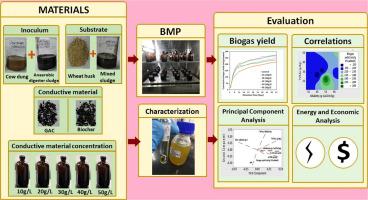Waste Management ( IF 8.1 ) Pub Date : 2021-02-14 , DOI: 10.1016/j.wasman.2021.01.032 Satya Brat Tiwari , Monika Dubey , Banafsha Ahmed , Pallavi Gahlot , Abid Ali Khan , Ankur Rajpal , A.A. Kazmi , Vinay Kumar Tyagi

|
Management of agro-waste is a major challenge globally due to inefficient disposal techniques, which concominantly leads pollution and loss of renewable bioenergy. Anaerobic digestion of agro-waste is one of the ways to tackle this problem but hindered by the recalcitrant nature of agro-waste. This study investigated the effect of granular activated carbon (GAC) and granular biochar (GBC) addition to enhance the thermophilic anaerobic co-digestion of wheat husk and sewage sludge. The conductive materials (particle size: 2–5 mm) were added separately at five different concentrations: 10, 20, 30, 40, 50 g/Linoculum. The findings revealed that samples amended with GAC and GBC at 20 g/L dosage had the highest biogas yield of 263 and 273 mL/gVSadded, respectively, corresponding to 22 and 27% higher yield than the control. Additionally, a shorter lag phase was observed in both cases compared to the Control. However, the GBC amended samples showed relatively stable biogas production compared to GAC and consistent results regarding pH, alkalinity, total volatile fatty acids, and soluble chemical oxygen demand. The preliminary techno-economic analysis indicates that addition of GAC or GBC may not be feasible and require other innovative engineered solutions for the addition of conductive materials. This study confirms that GAC and GBC amendments enhance the biogas productivity and process stability in anaerobic digestion of recalcitrant agro-waste under the high-temperature regime and calls for further research in this direction.
中文翻译:

碳基导电材料在高温条件下促进了农业废弃物的厌氧共消化
由于效率低下的处置技术,农业废物的管理是全球的主要挑战,这同时导致污染和可再生生物能源的损失。厌氧消化农业废物是解决这一问题的方法之一,但由于农业废物的顽强特性而受到阻碍。这项研究调查了颗粒状活性炭(GAC)和颗粒状生物炭(GBC)的添加对增强麦壳和污水污泥嗜热厌氧消化的影响。导电材料(粒度:2-5毫米):10,20,30,40,将50g / L的在五个不同浓度单独加入接种物。调查结果显示,在20克/升剂量随GAC和GBC修正该样品具有最高的产气量263和273毫升/ GVS加入分别比对照高22%和27%。另外,与对照相比,在两种情况下均观察到较短的滞后阶段。但是,与GAC相比,GBC修改后的样品显示出相对稳定的沼气生产,并且在pH值,碱度,总挥发性脂肪酸和可溶性化学需氧量方面具有一致的结果。初步的技术经济分析表明,添加GAC或GBC可能不可行,并且需要其他创新的工程解决方案来添加导电材料。这项研究证实,GAC和GBC修订版在高温条件下难降解农业废料的厌氧消化中提高了沼气生产率和过程稳定性,并呼吁对此方向进行进一步研究。



























 京公网安备 11010802027423号
京公网安备 11010802027423号